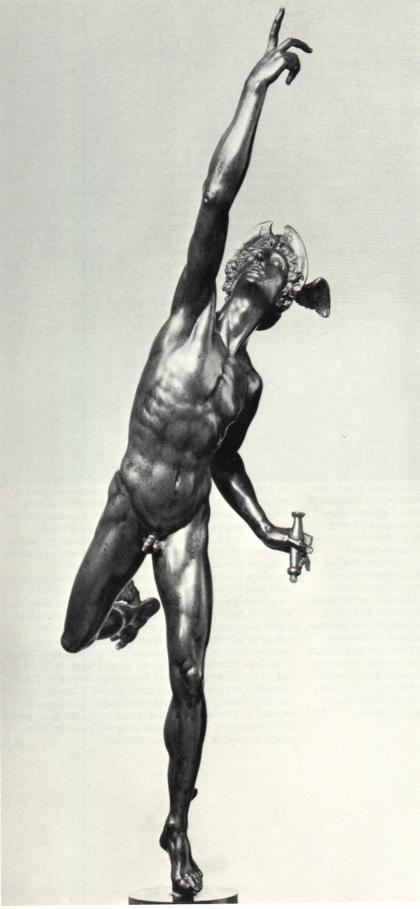

"Man and His World International Fine Arts Exhibition Expo 67 Montréal Canada" by Pierre Dupuy © the Canadian Corporation for the 1967 World Exhibition and the National Gallery of Canada
| Giovanni Bologna (Jean Bologne). 1529-1608
Mercury. c. 1575 Giovanni Bologna (Jean Bologne), Flemish by birth, was one of the most important sculptors in the history of Italian art: his influence is rivalled in the sixteenth century only by that of Michelangelo. Born in Douai in 1529, he first studied with Jacques Dubrœucq, a mannerist sculptor of Mons, and then about 1555 he went to Rome to study ancient and renaissance sculpture. Although he returned to Flanders two years later, he finally settled permanently in Florence. In 1560 he rose to prominence in the famous competition, which he lost to Bartolommeo Ammanati, for the Fountain of Neptune for the Piazza della Signoria. Later, primarily through the Medici princes, he received many commissions for private as well as for major public works. In his Rape of the Sabines in the Loggia dei Lanzi in Florence he proved that he was as adept in the creation of large marble monuments as he was of smaller bronzes. His impact abroad derives mainly from his bronzes, which were probably intended as diplomatic gifts. His most popular subject by far is Mercury, the messenger of the gods. The earliest version of about 1563 is now in the Museo Civico, Bologna. Equally well known is the Medici Mercury of 1580 in Florence. The Vienna example shown here probably dates from about 1575. It is one of the artist's best and most characteristic works and has been thought to have been sent by Cosimo di Medici to Maximilian II. The presence of the initials I.B. on the bronze is an indication that it was probably finished by the artist himself. The Mercury can be regarded as the epitome of late sixteenth-century ideals and canons of taste. Its composition was probably derived from a figure by Raphael in his famed frescos of 1518 in the Farnesina. The smooth, flowing surfaces of the bronze, the clearly defined contours, seen to advantage from all sides, and the ambiguous direction of movement are characteristic of the ideals sought by mannerist sculptors in sixteenth-century Italy. Yet, the artist has achieved an extraordinary balance of conflicting tensions, all poised on one foot of the god. In the rendering of this complex action, Giovanni Bologna rivals the sculpture of Michelangelo and predates the exploration of space by artists in the succeeding century. The soft plasticity which distinguishes Bologna's work from that of Michelangelo can be attributed to the former's use of bronze, a material seldom employed by the earlier master. The fifteenth - and sixteenth-century Italians turned to the cire perdue technique of bronze casting to emulate the statuettes of ancient Rome which were currently collected in humanist circles. Giovanni Bologna, however, in such works as his Mercury sought not only to match but to surpass in physical dexterity the art of the ancients. It was through his bronzes, widely acclaimed throughout Europe, and the works of his pupils, such as Susini, Tacca, and Francavilla, of considerable note in their own right, that Bologna's style became so dominate in the later sixteenth and early seventeenth centuries. |